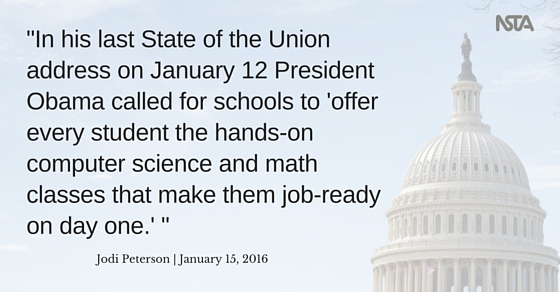President Obama Gives Shout Out to Computer Science and STEM in SOTU
By Jodi Peterson
Posted on 2016-01-15
In his last State of the Union address on January 12 President Obama called for schools to “offer every student the hands-on computer science and math classes that make them job-ready on day one.”
The President also mentioned the newly defunct No Child Left Behind, calling the new education bill (Every Student Succeeds Act) an important start, and pointed out his achievements to increase childhood education, lift high school graduation rates, and “boost graduates in fields like engineering.”
Following the State of the Union address, Acting U.S. Secretary John King kicked off his “Opportunity Across America” tour to discuss the Every Student Succeeds Act (ESSA).
According to the White House Office of Science and Technology, “Our economy is rapidly shifting, and educators are increasingly recognizing computer science as the new basic. There are over 600,000 high-paying technology jobs open across the U.S., and by 2018, 51 percent of all STEM jobs are projected to be in computer science-related fields. However, computer science (CS), is taught in less than 25 percent of American K-12 schools, even as other advanced economies, such as Britain, are making it available for all students aged 5-16. In addition, students of color, girls, and students in high-need schools are less likely to take computer science than other students, and few middle school or elementary schools offer any computer science experiences.”
Additional White House outreach to expand computer science education is expected soon.
In related news, the Computer Science Teachers Association, the Association for Computing Machinery, and Code.org are joining forces to create a K-12 Computer Science framework for educators and policy makers. Working with advisors within the computing community, and with several states and large school districts, technology companies, and other organizations, the groups will create a framework that will identify key K-12 computer science concepts and practices students should know at the end of grades 2, 5, 8, and 12.
Update on Every Student Succeeds Act
The Department of Education is busy drafting regulations for the ESSA, and advocates called on ED officials to ensure the new law is properly enforced during two public hearings this past week.
In December, ED issued a Dear Colleague Letter to states to clarify some questions (largely about Title I) about transitioning to the new law. The rule-making process is now underway, and teachers and teacher leaders can provide recommendations about the implementation of the new law until January 21. Draft regulations are expected out this spring. ESSA provisions will take effect at the start of the 2017-18 school year. Waivers to NCLB will end on August 1, 2016.
Supreme Court Hears Arguments on Union “Fair Share” Fees
Last week the Supreme Court heard oral arguments in the Friedrichs v. California Teachers Association case that could bar public-sector unions from collecting “fair-share” fees from non-members, a move that Politico says “could reduce union membership drastically and drain union coffers.”
Read more about the Supreme Court hearing last week, this EdSource background story on the case, and the NEA response.
Jodi Peterson is Assistant Executive Director of Legislative Affairs for the National Science Teachers Association (NSTA) and Chair of the STEM Education Coalition. e-mail Peterson at jpeterson@nsta.org; follow her on Twitter at @stemedadvocate.
The mission of NSTA is to promote excellence and innovation in science teaching and learning for all.
Follow NSTA
Disclaimer: The views expressed in this blog post are those of the author(s) and do not necessarily reflect the official position of the National Science Teaching Association (NSTA).



